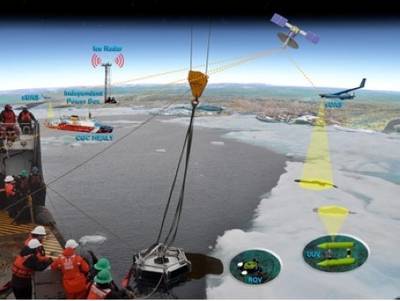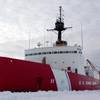Coast Guard to Test Arctic Oil Spill Technologies
The U.S. Coast Guard Research and Development Center (RDC) plans to test and evaluate oil spill detection and recovery technologies in the Arctic Ocean as part of Operation Arctic Shield 2013.
A multi-agency team of engineers and scientists led by RDC researchers will conduct a series of demonstrations in September 2013 aboard Coast Guard Cutter Healy to test and evaluate capabilities of various unmanned aerial systems (UAS), an unmanned underwater vehicle (UUV) and a remotely operated vehicle (ROV) to search for simulated oil spills.
To support planned UAS testing, the RDC has assembled a team to include National Oceanographic and Atmospheric Administration (NOAA) personnel operating a Puma UAS; University of Alaska, Fairbanks researchers operating Puma systems funded by The Center for Island, Maritime, and Extreme Environment Security; representatives from the Department of Homeland Security Science and Technology Center of Excellence and personnel from the U.S. Air Force Special Operations Command. The team will also assess the capabilities of the UAS to support other Coast Guard operational missions while onboard the Healy.
Tests will also include operation of a SeaBED UUV by Woods Hole Oceanographic Institute (WHOI) researchers. The UUV involvement is part of a research effort funded by the Bureau of Safety and Environmental Enforcement (BSEE). Members from BSEE have been working with WHOI researchers to establish methods to detect, measure, and map oil under, or encapsulated within, Arctic sea ice. Tests will build on work that has been performed by BSEE to evaluate several candidate sensors to establish a sensor suite capable of detecting and quantifying the thickness of oil from below the ice. The emphasis during this evaluation will be on system deployment and recovery, two-way communication, ice-bottom mapping and search pattern development.
NOAA personnel will also employ the Environmental Response Management Application online mapping tool that integrates both static and real-time data for use during the exercise. The Coast Guard is providing one of its brushed skimmer systems to simulate recovery operations at the ice edge and a Video Ray PRO 4 ROV to provide a vantage point from below to observe and document skimming operations.
Coast Guard Cutter Healy, commissioned in 2000, is the nation’s newest and largest polar icebreaker. The cutter is 420 feet long and has extensive scientific capabilities.











